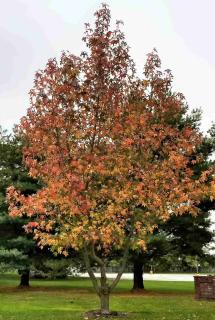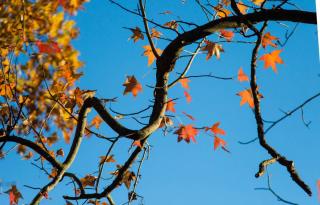

The sweetgum tree is reputed for its nice star-shaped leaves and the flamboyant yellow, orange and red hues it displays in fall.
Summary of Sweetgum facts
Name – Liquidambar styraciflua
Family – Hamamelidaceae
Type – tree
Height – 25 to 115 feet (8 to 35 m)
Soil – ordinary, well drained
Exposure – full sun
Foliage – deciduous

You may also plant container-bought sweetgum in spring.
Note that the size of sweetgum trees is very variable, and ranges from 25 to 115 feet (8 to 35 m) depending on the variety and the growing conditions.

During the first two years after planting, water your sweetgum regularly, especially in case of dry spell or extreme heat.
Once properly settled in, sweetgum normally is able to answer its needs by finding water in the soil on its own, so no need to water anymore.
Native to North America, sweetgum is a very ornamental tree that also procures excellent quality wood for furniture-making. It is also more familiar to many under the name liquidambar. It’s sometimes even written out “Liquid Amber tree”, which is also true in a way!
From its wood and fruits, a sap can be extracted, usually called sweetgum balsam or Peru balsam that the Cherokee Indians used as chewing gum and is today used in infusions for its capacity to sooth the respiratory system, fight diarrhea and reduce stress.
Sweetgum is also a true marvel in fall with its purple hues that set the garden on fire.
Note that if your sweetgum doesn’t bear fruit, this is probably because it is a sterile cultivar called Liquidambar styraciflua ‘Rotundiloba’ that was created specifically so that the fruits, which are very slippery when burst, would not lead to accidents on parkings or along roads.
Sweetgum never bears fruit before the age of 25 years.
Growth is relatively slow.
Adding fertilizer won’t speed it up, however, regular amendments based on manure and seaweed will actively support the proper growth of the tree.
Moved into house in central Illinois 25 yrs ago and has a maple and sweetgum in yard. The sweetgum was perhaps 3-5 yrs old at the time, and the maple was probably 15-20. Now they are almost exactly same size at trunk and heighth.
Main con about the tree is it’s hard seed pods dropping after the leaves in the fall/early winter. Seems to be too much raking effort for the pods after already doing leaves…ugh.